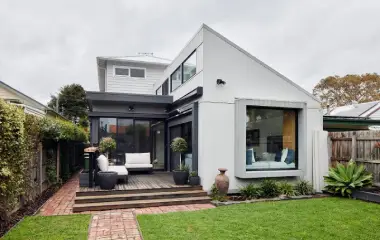“There’s no place like home” Dorothy was right, there’s nothing like it.
My fondest childhood memories were forged growing up in a beautiful solid brick Californian Bungalows in Camberwell. This home with its homely earthy character and its distinctive heavily built pylon shaped veranda posts hosted many family Christmases and gatherings.
The house sat at the front of a large expansive block giving way to an informal backyard, big enough to entertain our large extended family and our very big German shepherd ‘Rex.’
Early-style bungalows
.webp)
Bungalows built in the early 20th century came in a variety of exterior looks. From Hollywood Spanish, Georgian Revival, Old English and of course the most popular of them all; the Californian.
The history of the name
The word bungalow is derived from ‘Bangla’, which means a Bengali House. It’s a term brought via the British Raj in India where deep shady veranda’s and a cool gin and tonic were the order of the day.
As its names suggest, the Californian bungalows originated in California and the first of its kind was imported from Pasadena California in 1916 by an Australian Real Estate Agent who had it erected in the Sydney suburb of Rosebery for the show.
And so began Australia’s love affair with this solid and unassuming house. It became one of the most popular house styles of the 1920’s and represented a modern lifestyle. With its ‘Craftsman’ design, use of natural materials and lack of frills, it was a solid, respectable and affordable house ideally suited for the Australian culture.
Structures & floor plans
Built for the warmer climate of California, houses were built low, with shallow pitched roofs of terracotta or slate, the veranda tucked under the main roof.
The floor plan of our Californian Bungalows was more open than the earlier Victorian and Federation homes. The dining and lounge rooms were separated by a short entry hallway, and each room featured beautiful timber framed dividing doors.
The hero of the dining room was a beautiful bay casement window with Art Deco leadlight and a built in timber window seat. Growing up, I was lucky enough to have parents who enforced the act of eating at the dinner table. It was a brief moment where conversations and stories of the day’s events were shared over the evening meal.
The lounge was partially panelled in dark timber with a plate shelf above the fireplace where mum kept her collection of large conch shells from Mauritius. Down the central hallway past the bedrooms, were the bathroom and kitchen. To the dismay of my mother, the laundry was outside, situated next to the back porch.
Where to find a 'Cal-Bung'

Today the ‘Cal Bung’ as it is affectionately called can be found in the thousands across Melbourne and Supa Group has renovated and extended hundreds of these homes. Generally situated on large blocks and originally designed for modern and informal living, it is ideal for extending and renovating. The simplistic floor plan allows for easy modernisation whilst maintaining aspects of its original charm.





.webp)












